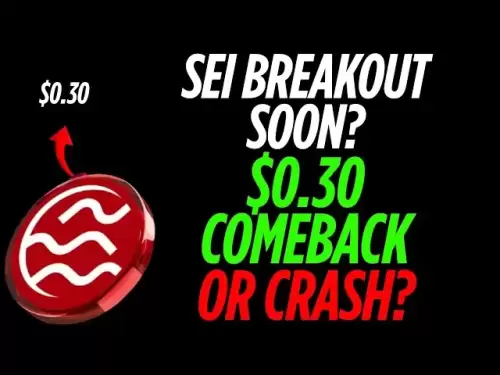-
 Bitcoin
Bitcoin $109,583.2239
0.19% -
 Ethereum
Ethereum $2,583.4612
0.48% -
 Tether USDt
Tether USDt $1.0003
-0.04% -
 XRP
XRP $2.2681
0.70% -
 BNB
BNB $659.9218
-0.52% -
 Solana
Solana $151.4961
-0.37% -
 USDC
USDC $0.9999
-0.02% -
 TRON
TRON $0.2861
1.20% -
 Dogecoin
Dogecoin $0.1718
0.04% -
 Cardano
Cardano $0.5960
-0.07% -
 Hyperliquid
Hyperliquid $40.1233
2.85% -
 Sui
Sui $2.9974
2.48% -
 Bitcoin Cash
Bitcoin Cash $497.1279
-1.76% -
 Chainlink
Chainlink $13.7275
-0.22% -
 UNUS SED LEO
UNUS SED LEO $9.0241
0.70% -
 Avalanche
Avalanche $18.5536
-0.88% -
 Stellar
Stellar $0.2421
1.39% -
 Toncoin
Toncoin $2.8593
-0.51% -
 Shiba Inu
Shiba Inu $0.0...01187
-0.07% -
 Litecoin
Litecoin $90.0023
2.90% -
 Hedera
Hedera $0.1590
2.79% -
 Monero
Monero $322.1495
0.00% -
 Polkadot
Polkadot $3.5453
-1.00% -
 Dai
Dai $1.0000
-0.01% -
 Bitget Token
Bitget Token $4.5733
-1.06% -
 Ethena USDe
Ethena USDe $1.0002
-0.01% -
 Uniswap
Uniswap $7.6345
3.03% -
 Aave
Aave $279.2583
0.47% -
 Pepe
Pepe $0.0...01003
-1.52% -
 Pi
Pi $0.4941
-0.32%
How many times is the leverage of a Bitcoin contract
Leverage, a financial tool in Bitcoin trading, amplifies potential returns and risks by enabling traders to access larger positions using borrowed funds, offering various levels of amplification based on risk tolerance and trading strategy.
Nov 11, 2024 at 12:55 am

Unleashing the Power of Leverage: Exploring the Flexibility of Bitcoin Contracts
Leverage is a powerful tool in the realm of trading, enabling traders to amplify their potential returns while simultaneously magnifying their risk exposure. In the dynamic world of Bitcoin trading, understanding and effectively utilizing leverage is crucial for maximizing profit potential and mitigating potential losses. This comprehensive exploration will delve into the intricacies of leverage in Bitcoin contracts, addressing key questions and providing a comprehensive overview of this essential trading strategy.
Demystifying Leverage: What is it and How Does it Work?
Leverage is a financial mechanism that allows traders to access a larger trading position than their initial capital would otherwise permit. It operates on the principle of borrowing funds from a broker to increase the size of the trade, thereby potentially multiplying both profits and losses. Leverage is expressed as a ratio, such as 10:1 or 50:1, indicating the proportion of borrowed funds to the trader's own capital.
Exploring the Leverage Spectrum: Understanding the Different Levels
Leverage in Bitcoin contracts varies widely, ranging from conservative levels suitable for risk-averse traders to aggressive ratios designed for experienced traders with a high tolerance for volatility. The choice of leverage depends on individual risk appetite, trading strategy, and market conditions.
- Low Leverage (1:1 to 5:1): Suitable for beginners and risk-averse traders seeking to limit potential losses. Provides a safety net and minimizes the impact of market fluctuations.
- Moderate Leverage (10:1 to 20:1): A balanced approach suitable for traders with some experience and a moderate risk tolerance. Offers the potential for higher returns while maintaining a reasonable level of risk.
- High Leverage (50:1 to 100:1 or more): Reserved for experienced traders with a high risk appetite and the ability to withstand significant market movements. Comes with the potential for exponential profits but also carries the risk of substantial losses.
Calculating Leverage: Determining the Amplification Effect
Calculating leverage is straightforward, involving a simple formula:
Leverage (Ratio) = Loan Amount / Trader's CapitalFor instance, a trader with a $1,000 capital and a leverage ratio of 20:1 would effectively control a $20,000 trading position, with the broker providing the additional $19,000.
Maximizing Leverage: Tips for Effective Utilization
Harnessing the power of leverage effectively requires a disciplined approach and careful consideration of several key factors:
- Risk Management: Implement robust risk management strategies to mitigate potential losses. Utilize stop-loss orders, position sizing, and hedging techniques to manage risk exposure.
- Market Analysis: Conduct thorough market analysis to identify trading opportunities and assess market volatility. Leverage should be adjusted based on market conditions.
- Emotional Control: Maintain emotional discipline and avoid impulsive trading. Leverage can amplify both profits and losses, making it crucial to control emotions and stick to trading plans.
- Choose a Reputable Broker: Select a trustworthy and regulated broker that offers reliable trading infrastructure, competitive leverage options, and transparent trading conditions.
Types of Leverage Contracts: Exploring the Trading Landscape
Leverage in Bitcoin contracts can be accessed through various instruments, each with its unique characteristics:
- Futures Contracts: Standardized contracts traded on exchanges, offering high leverage but requiring a sophisticated understanding of futures trading.
- Perpetual Futures Contracts: Similar to futures contracts but without an expiration date, allowing traders to hold positions indefinitely.
- Margin Trading: Involves borrowing funds from a broker to trade spot Bitcoin, offering greater flexibility but potentially higher borrowing costs.
Conclusion
Leverage is a powerful tool that can enhance trading potential in the dynamic Bitcoin market. By understanding the mechanics of leverage, traders can harness its benefits while managing the associated risks. Carefully selecting a leverage ratio, implementing sound risk management strategies, and choosing a reputable broker are essential for successful leveraging in Bitcoin trading.
Disclaimer:info@kdj.com
The information provided is not trading advice. kdj.com does not assume any responsibility for any investments made based on the information provided in this article. Cryptocurrencies are highly volatile and it is highly recommended that you invest with caution after thorough research!
If you believe that the content used on this website infringes your copyright, please contact us immediately (info@kdj.com) and we will delete it promptly.
- BONK Price Prediction: Meme Coin Mania and What's Next?
- 2025-07-04 12:30:13
- NYAG, Stablecoins, and FDIC Protections: Navigating the Regulatory Maze
- 2025-07-04 13:10:15
- Level Up Your DeFi Game: Phantom Wallet and the Ultimate DeFi Experience
- 2025-07-04 13:10:15
- Bitcoin Surge: Breaking Down the $109,000 Barrier and the Road to $165,000?
- 2025-07-04 12:30:13
- Solana ETF Inflows & Snorter Token: A New Era for Meme Coin Trading?
- 2025-07-04 12:50:12
- Ripple, Stablecoin, and First Bank: Decoding the Latest Moves in Crypto
- 2025-07-04 12:50:12
Related knowledge

How to identify the contract value range in combination with the market profile?
Jul 02,2025 at 10:56pm
Understanding the Market ProfileTo effectively identify the contract value range in combination with the market profile, it's essential to first understand what each concept entails. The market profile is a framework that helps traders visualize how price and time interact across a given period, typically a trading day or session. It provides insights i...

How to use the price slope to filter the false breakthrough signal of the contract?
Jun 20,2025 at 06:56pm
Understanding the Concept of Price Slope in Contract TradingIn contract trading, especially within cryptocurrency derivatives markets, price slope refers to the rate at which the price changes over a specific time period. It helps traders assess the strength and sustainability of a trend. A steep slope may indicate strong momentum, while a shallow slope...

How to determine the expected volatility of the contract through the volatility cone?
Jun 19,2025 at 12:28pm
Understanding the Basics of Volatility in Cryptocurrency ContractsIn the realm of cryptocurrency trading, volatility is a key metric that traders use to assess potential risk and reward. When dealing with futures contracts, understanding how volatile an asset might become over time is crucial for position sizing, risk management, and strategy developmen...

How to formulate a contract intraday trading plan in combination with the pivot point system?
Jun 21,2025 at 03:42pm
Understanding the Basics of Pivot Points in Cryptocurrency TradingPivot points are technical analysis tools used by traders to identify potential support and resistance levels. These levels are calculated using the previous day's high, low, and closing prices. In the context of cryptocurrency trading, where markets operate 24/7, pivot points help trader...

How to adjust the contract position ratio through the price fluctuation entropy?
Jun 22,2025 at 11:42am
Understanding Price Fluctuation Entropy in Cryptocurrency ContractsIn the world of cryptocurrency futures trading, price fluctuation entropy is a relatively new concept used to measure market volatility and uncertainty. It derives from information theory, where entropy refers to the degree of randomness or unpredictability in a system. In crypto contrac...

How to use the volume swing indicator to predict the contract volume-price divergence?
Jun 18,2025 at 11:42pm
Understanding the Volume Swing IndicatorThe volume swing indicator is a technical analysis tool used primarily in cryptocurrency trading to evaluate changes in volume over time. Unlike price-based indicators, this metric focuses solely on trading volume, which can provide early signals about potential market reversals or continuations. The key idea behi...

How to identify the contract value range in combination with the market profile?
Jul 02,2025 at 10:56pm
Understanding the Market ProfileTo effectively identify the contract value range in combination with the market profile, it's essential to first understand what each concept entails. The market profile is a framework that helps traders visualize how price and time interact across a given period, typically a trading day or session. It provides insights i...

How to use the price slope to filter the false breakthrough signal of the contract?
Jun 20,2025 at 06:56pm
Understanding the Concept of Price Slope in Contract TradingIn contract trading, especially within cryptocurrency derivatives markets, price slope refers to the rate at which the price changes over a specific time period. It helps traders assess the strength and sustainability of a trend. A steep slope may indicate strong momentum, while a shallow slope...

How to determine the expected volatility of the contract through the volatility cone?
Jun 19,2025 at 12:28pm
Understanding the Basics of Volatility in Cryptocurrency ContractsIn the realm of cryptocurrency trading, volatility is a key metric that traders use to assess potential risk and reward. When dealing with futures contracts, understanding how volatile an asset might become over time is crucial for position sizing, risk management, and strategy developmen...

How to formulate a contract intraday trading plan in combination with the pivot point system?
Jun 21,2025 at 03:42pm
Understanding the Basics of Pivot Points in Cryptocurrency TradingPivot points are technical analysis tools used by traders to identify potential support and resistance levels. These levels are calculated using the previous day's high, low, and closing prices. In the context of cryptocurrency trading, where markets operate 24/7, pivot points help trader...

How to adjust the contract position ratio through the price fluctuation entropy?
Jun 22,2025 at 11:42am
Understanding Price Fluctuation Entropy in Cryptocurrency ContractsIn the world of cryptocurrency futures trading, price fluctuation entropy is a relatively new concept used to measure market volatility and uncertainty. It derives from information theory, where entropy refers to the degree of randomness or unpredictability in a system. In crypto contrac...

How to use the volume swing indicator to predict the contract volume-price divergence?
Jun 18,2025 at 11:42pm
Understanding the Volume Swing IndicatorThe volume swing indicator is a technical analysis tool used primarily in cryptocurrency trading to evaluate changes in volume over time. Unlike price-based indicators, this metric focuses solely on trading volume, which can provide early signals about potential market reversals or continuations. The key idea behi...
See all articles

























































































